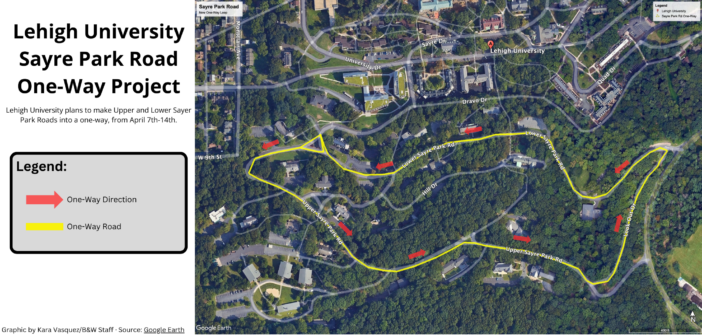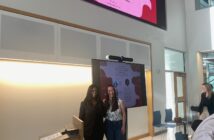From April 7 to April 14, Lehigh is launching The Sayre Loop Pilot Program. The program will convert Lower and Upper Sayre roads into one-way streets for the week to examine its efficiency in improving motorist and pedestrian safety and increasing connectivity between the three Lehigh campuses.
LUPD Police Chief Jason Schiffer said if this pilot program is deemed successful, it will become a permanent traffic change in the upcoming years.
Schiffer said this project was created with pedestrian safety in mind, as it has always been one of his main concerns on campus.
“People just walk in the street because there’s little alternative,” Schiffer said. “Now we want to try and give them a buffer and a safe place to walk while maintaining a travel lane.”
During the testing week, the university will use pedestrian and motorist feedback to weigh how it affects daily life. There will be staff stationed at two tables to direct traffic, answer any questions and receive student feedback.
Joe Klocek, director of Planning, Design and Construction, said the project’s timing was chosen strategically.
“It’s an active time, it’s spring,” Klocek said. “We’re hoping there’ll be more people out and about and there will be a lot of activity on the hill.”
Several students, including Annie Casano, ‘26, have said they believe adding sidewalks would be a more beneficial approach.
Schiffer said he does not disagree with this idea, but the one-way loop is currently the most cost-effective solution.
“Constructing sidewalks may be the best method, but the cost would be extraordinary because of the terrain,” Schiffer said.
Klocek said improving connectivity between campuses is only the first step in bridging the gap. Sidewalks and hiking trails have been discussed as a potential future endeavor as well.
Casano said she hopes the traffic change will improve safety for both pedestrians and drivers as the roads currently can be difficult to navigate.
“(For) many of my friends who have cars, pulling out of our parking lot on Lower Sayre Drive is very hazardous because of the two-way road,” Casano said. “You can’t really see cars coming from specific turns.”
For students who frequently travel between campuses, the change may take some getting used to.
Grace Aggen, ‘26, is a student athlete who lives in Sayre Park Village.
“I have to drive every day on the Sayre roads for practice and it will affect how long it takes me to get to practice because of traffic,” Aggen said. “But as a resident in Sayre, I think it’s a good idea because it’s hard getting down every day without sidewalks for us to walk on.”
According to the Department of Transportation, studies have shown converting two-way streets into one-way streets can decrease the number of pedestrian accidents. That said, it was also reported that drivers tend to increase their speed on these roads.
The Department of Transportation states the benefits of a one-way street are highly dependent on an individual area and need to be carefully evaluated.
Klocek said student responses will be crucial for collecting data and furthering the project.
“Part of us doing this pilot program is about seeing how folks respond to it,” Klocek said. “If we can get through that one-week pilot program and the response is generally positive, I think that’ll go a long way in helping us take next steps.”






Comment policy
Comments posted to The Brown and White website are reviewed by a moderator before being approved. Incendiary speech or harassing language, including comments targeted at individuals, may be deemed unacceptable and not published. Spam and other soliciting will also be declined.
The Brown and White also reserves the right to not publish entirely anonymous comments.